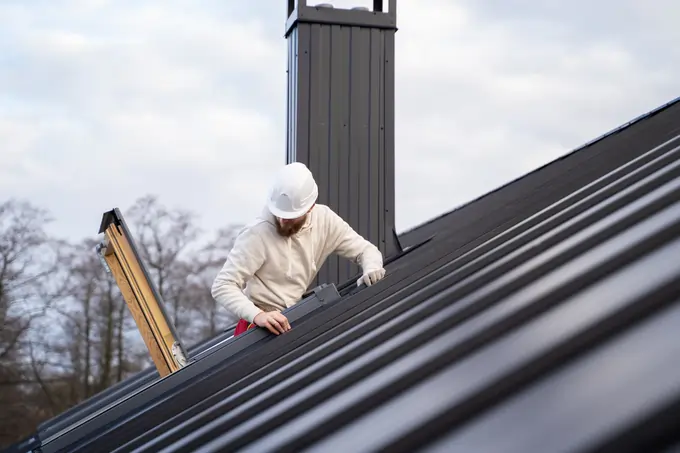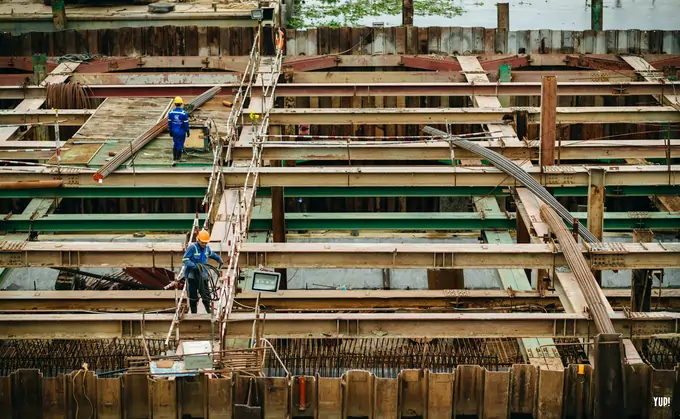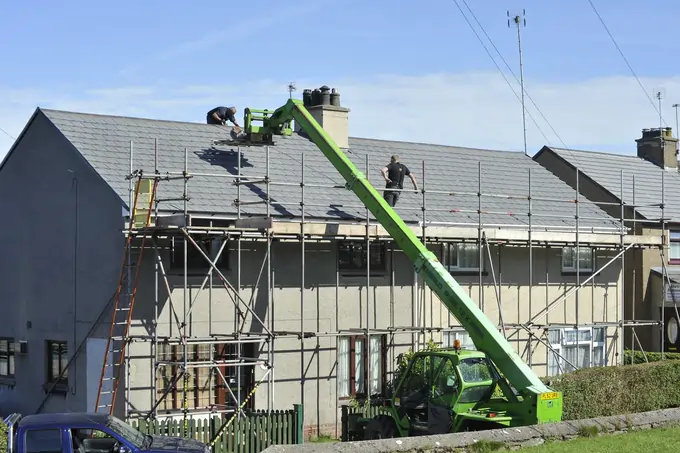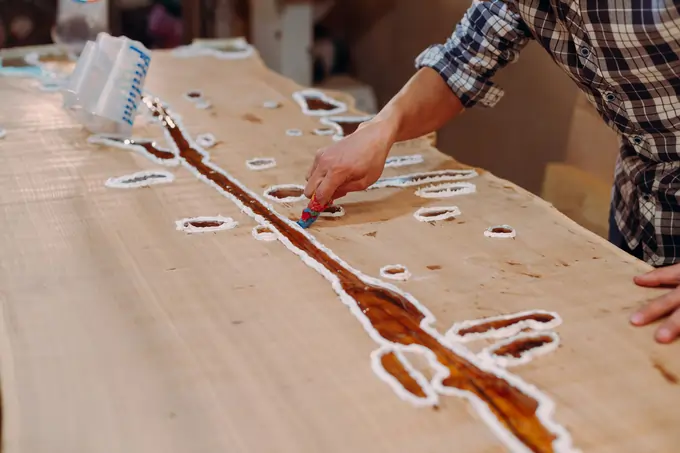Are you tired of leaky roofs and sky-high energy bills?
Flat roofs might be the solution you’ve been looking for.
But with so many options out there, how do you choose the right one?
In this article, we’ll dive into the world of flat roofs and help you make an informed decision.
Flat roofs are becoming increasingly popular in residential buildings.
They offer a sleek, modern look and can even provide extra living space.
But not all flat roofs are created equal.
Let’s explore the different types of flat roof materials and find out which one is best for your home.
What Are the Different Types of Flat Roof Materials?
When it comes to flat roofs, you have several options to choose from.
Each type has its own unique properties and benefits.
Let’s break them down.
Understanding the Basics of Built-up Roofing
Built-up roofing (BUR) is one of the oldest and most reliable flat roof systems.
It consists of many layers of bitumen and reinforcing fabric.
The top layer of gravel provides protection from the elements.
BUR systems are known for their durability and longevity.
They can last up to 30 years with proper maintenance.
However, they are heavy and require a strong roof deck for support.
What is Modified Bitumen Roofing?
Modified bitumen roofing is a step up from traditional BUR systems.
It uses asphalt that has been modified with polymers for increased flexibility.
This type of roofing is available in large sheets, making installation faster and easier.
Modified bitumen roofs can last 20-30 years with proper care.
They’re also more resistant to extreme temperatures than BUR systems.
An Overview of Single-Ply Membrane Roofing
Single-ply membrane roofing is a modern alternative to BUR and modified bitumen.
It’s made from synthetic materials like EPDM, TPO, or PVC.
These roofs are lightweight, easy to install, and highly resistant to UV rays.
Single-ply roofs can last 20-30 years and are often more affordable than other options.
But which type of single-ply roofing is right for you?
Let’s find out in the next section.
How Do You Choose the Right Roofing Material?

Choosing the right flat roof material isn’t just about looks.
You need to consider several factors to ensure you get the best roof for your needs.
Let’s explore what you should keep in mind.
Factors to Consider: Durability and Longevity
The durability of your roof is crucial.
A flat roof that lasts longer saves you money in the long run.
EPDM roofs, made from synthetic rubber, are known for their durability.
They can withstand harsh weather conditions and last up to 50 years.
TPO roofs offer similar benefits but with better energy efficiency.
Consider how long you plan to stay in your home when choosing a roof material.
Impact of Climate on Your Roof Choice
Your local climate plays a big role in choosing the right roof.
If you live in a hot, sunny area, a reflective roof like TPO might be best.
For areas with heavy rainfall, a roof with excellent waterproofing is crucial.
BUR systems excel in this area, but modern single-ply roofs are catching up.
What about extreme weather events?
We’ll cover that later in the article.
Cost and Ease of Installation
Budget is always a concern when it comes to home improvements.
Flat roofs tend to be more affordable than sloped roofs.
But prices vary depending on the material and installation techniques.
Single-ply roofs are usually the most cost-effective option.
They’re also quicker to install, which can save on labor costs.
But is cheaper always better?
Let’s look at the pros and cons of each roof type.
What Are the Pros and Cons of Popular Flat Roof Types?
Every roofing material has its strengths and weaknesses.
Understanding these can help you make the best choice for your home.
Let’s break down the pros and cons of the most popular flat roof types.
The Advantages and Drawbacks of BUR Systems

BUR systems are tried and true.
They offer excellent waterproofing and can handle foot traffic well.
The multiple layers provide great insulation, keeping your home comfortable.
However, BUR roofs are heavy and installation is labor-intensive.
They also don’t perform well in extreme temperature fluctuations.
Is the traditional approach always best?
Let’s look at some modern alternatives.
Examining the Durability of EPDM Roofing
EPDM roofing is a type of single-ply membrane known for its durability.
It’s resistant to UV rays, ozone, and extreme temperatures.
EPDM roofs are lightweight and easy to install.
They’re also one of the most affordable options.
But EPDM isn’t perfect.
It can be punctured by sharp objects and may not be as aesthetically pleasing as other options.
Is there a material that combines durability with good looks?
Is PVC Roofing a Popular Choice for Homes?
PVC roofing is gaining popularity in the residential market.
It’s highly durable and resistant to chemicals, fire, and wind.
PVC roofs are also energy-efficient, reflecting sunlight to keep your home cooler.
They can be installed quickly and easily, saving on labor costs.
However, PVC roofs are more expensive than some other options.
They may also release harmful chemicals if not properly disposed of at the end of their life.
Now that we’ve covered the basics, let’s look at how these roofs perform in different weather conditions.
How Does Weather Conditions Affect Flat Roofs?
Weather is one of the biggest challenges for any roof.
Flat roofs face unique challenges due to their low slope.
Let’s explore how different weather conditions impact flat roofs and what you can do about it.
Resisting Water with Waterproof Membranes
Water is the enemy of any roof, but especially flat roofs.
Without proper drainage, water can pool and cause leaks.
Modern flat roofs use advanced waterproof membranes to combat this issue.
PVC and TPO roofs excel in this area, with heat-welded seams that prevent water infiltration.
EPDM roofs are also highly water-resistant when properly installed.
But what about extreme weather events?
We’ll cover that next.
Managing Temperature with Reflective Roofing

Temperature fluctuations can cause roofs to expand and contract.
This can lead to cracks and leaks over time.
Reflective roofing materials like TPO and PVC help manage temperature.
They reflect sunlight, keeping your roof and home cooler.
This can lead to significant energy savings in hot climates.
But what about cold climates?
We’ll discuss that in the next section.
Protecting Against Wind Damage
High winds can be devastating to flat roofs.
They can lift and tear roofing materials, especially at the edges.
Proper installation is key to wind resistance.
Fully adhered systems tend to perform better in high winds than mechanically fastened ones.
PVC and TPO roofs, when properly installed, offer excellent wind resistance.
But even the best roof needs regular maintenance.
Let’s look at how to keep your flat roof in top shape.
How to Maintain and Extend the Life of Your Flat Roof?
A well-maintained roof lasts longer and performs better.
Regular maintenance can save you money in the long run.
Let’s explore some key maintenance tips for flat roofs.
Regular Inspections and Roof Drain Management
Regular inspections are crucial for flat roofs.
Check for signs of damage at least twice a year.
Pay special attention to seams, flashings, and drainage areas.
Keeping your roof drains clear is essential.
Clogged drains can lead to water pooling and eventual leaks.
Clear debris regularly and ensure your drains are functioning properly.
But what if you do find damage?
Repairing Damage Quickly to Prevent Leaks
Small problems can quickly become big ones if left unaddressed.
If you notice any tears, punctures, or lifting seams, repair them immediately.
Many roofing materials come with DIY repair kits for small issues.
For larger problems, it’s best to call in a professional.
Quick repairs can prevent leaks and extend the life of your roof.
But prevention is even better than cure.
Protective Coatings and Roof Membrane Care

Protective coatings can add years to the life of your flat roof.
They provide an extra layer of protection against UV rays and weather.
Different roofing materials require different types of coatings.
Consult with a roofing professional to find the best option for your roof.
Regular cleaning can also help maintain your roof membrane.
Use gentle cleaners and avoid harsh chemicals that could damage the roofing material.
But what if maintenance isn’t enough?
Sometimes, a roof replacement is necessary.
What Are the Key Considerations for Roof Replacement?
Even the best-maintained roof will eventually need replacement.
Knowing when and how to replace your roof can save you time and money.
Let’s look at some key considerations for roof replacement.
Signs It’s Time for a New Roof
Most flat roofs last 20-30 years.
But age isn’t the only factor to consider.
Look for signs like persistent leaks, large areas of damage, or sagging.
If your energy bills are rising unexpectedly, your roof may be losing its insulating properties.
Multiple repairs in a short time can also indicate it’s time for a replacement.
But how do you choose the right person for the job?
Selecting a Reliable Roofing Contractor
Choosing the right contractor is crucial for a successful roof replacement.
Look for licensed and insured professionals with experience in flat roofs.
Ask for references and check online reviews.
Get multiple quotes and compare them carefully.
The cheapest option isn’t always the best.
Look for a contractor who uses quality materials and offers a solid warranty.
But what about the replacement process itself?
How to Plan for Your Roof Remodel Project
Replacing a flat roof is a significant project.
Plan for it to take several days, depending on the size of your roof and the material chosen.
Consider the time of year – spring or fall are often ideal for roofing projects.
Prepare your home by covering or removing items in the attic.
Inform your neighbors about the upcoming work.
Remember, a new roof is an investment in your home’s future.
Choose wisely and your new flat roof will serve you well for decades to come.
People Ask
What type of roofing is best for a flat roof?
Choosing the best type of roofing for a flat roof can be tricky stuff. A classic move is tar and gravel, which provides solid roof protection. Then you’ve got ethylene propylene diene monomer (EPDM)—super watertight and awesome for roofing applications.
Or there’s fiberglass with polyester layers, creating a sturdy roofing system made to last. If you’re into eco-friendly vibes, green roof options give you a lush roof surface. And for something highly versatile, liquid roofing can seal up those low spots perfectly.
Are flat roofs a good idea?
So, you’re wondering if flat roofs are a good idea? Well, it really depends on what you’re looking for. For instance, residential flat roofing often uses a roofing system made from materials like fiberglass, tar, or ethylene propylene diene monomer to ensure the surface is watertight. This type of roof construction is great for maximizing roof space and even installing a green roof, which is super cool for eco-friendly home design.
Another plus is that flat roofs are usually more affordable than their steeply pitched roof cousins, making them an appealing roofing option. But, flat roofs require regular maintenance, especially since they don’t naturally shed water like traditional roofing. Low-slope and flat roofs might face issues like pooling water, which means a solid roof protection strategy is crucial.
On the flip side, flat or low-slope roofs can be a good fit depending on the type of roofing system you use. You’ve got options like liquid roofing and metal roofing, both designed for different roofing applications. Even though roofs often look flat, they usually have a slight angle to help with drainage. The key is to choose the right materials and keep an eye on maintenance to ensure these different flat roof designs can handle the elements and provide long-term reliability.
What is a flat roof called?
In the roofing industry, a flat roof is called, well, a flat roof! These roofs are typically seen in commercial buildings and are usually less than 10 degrees in pitch. Flat roofs are popular due to their versatility and the modern materials available now.
However, these roofs are not suitable for all climates because they need to have an ability to withstand harsh weather. To help with that, they often include an insulation layer.
With several types of materials available, roofing is a popular choice for cost-effective and durable structures.
Is flat roof cheaper than shingles?
So, you’re wondering if a flat roof is cheaper than shingles? Well, flat roofs can often save you some cash due to the simpler design. But, keep in mind, flat roofs may need more maintenance over time. So, it sort of balances out in the long run!



